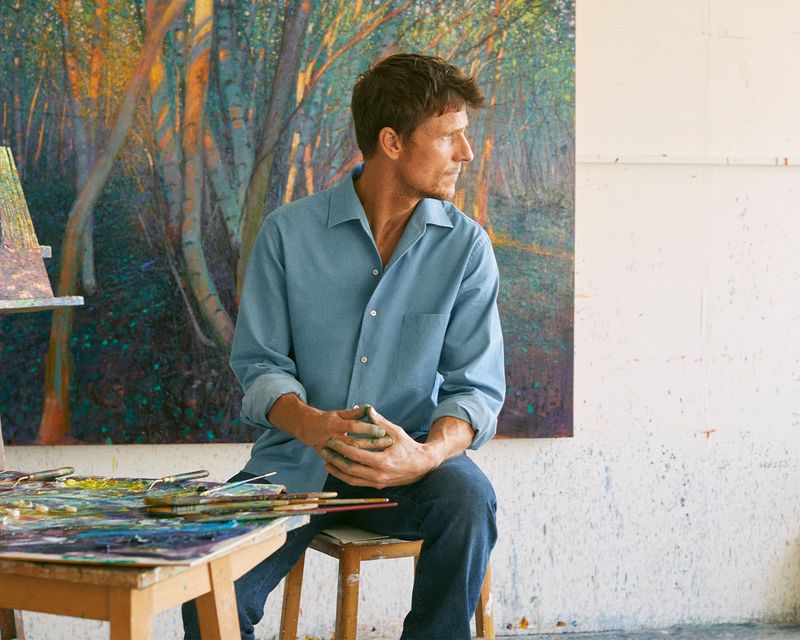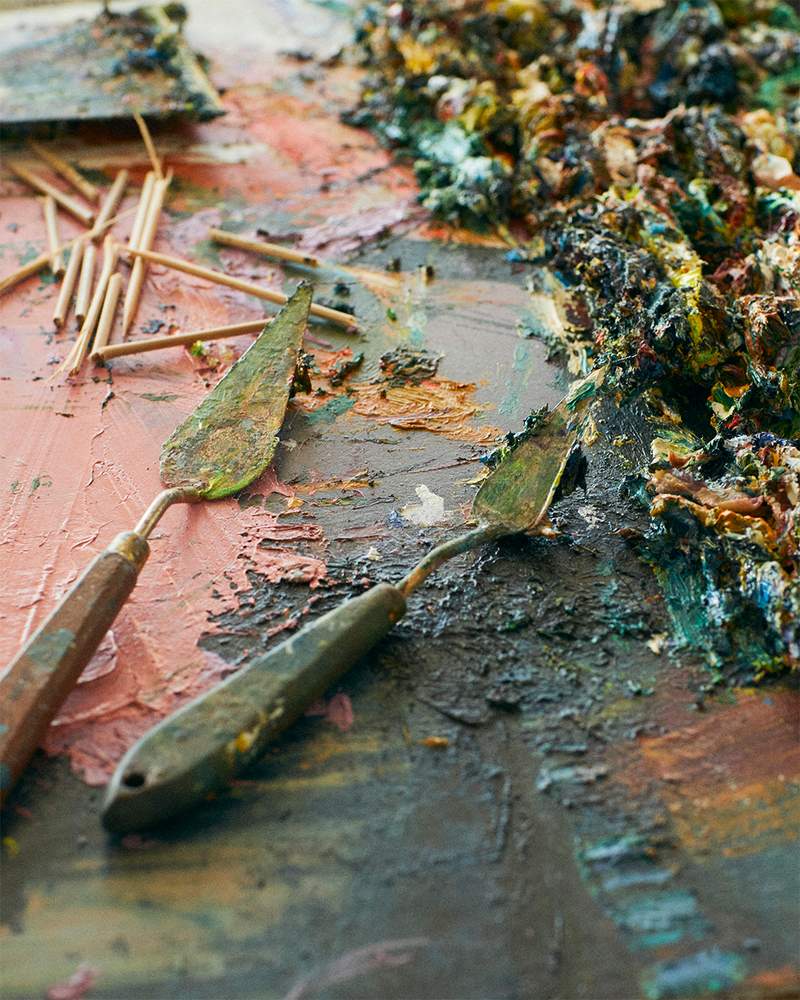THE JOURNAL

One of the most instructive things about travel is how it makes you feel about home. Over the past 25 years, Mr Andrew Gifford has travelled an awful lot. He has set up his easel and painted on the streets of Berlin, Paris and Budapest; New York, Hong Kong and St Petersburg. He has painted in the backwaters of the Yemen, Palestine’s West Bank and Kolkata in India. His stunning urban portraits, which are included in major public and private collections across the world, serve as a unique record of these far-flung artistic excursions, as well as documenting his enduring fascination with the play of light.
Mr Gifford’s process begins with a mixture of plein-air painting and theatrical performance, one that attracts crowds wherever he goes. Onlookers find themselves drawn in by the affable, optimistic Englishman painting from the back of a rikshaw or by night with a headtorch on or up to his knees in snow. They are often intrigued by the seemingly innocuous scenes he chooses as his subjects, and then transfixed by the way he reveals their beauty in small oil paintings that coalesce in a flurry of rapid, dynamic mark-making. The art Mr Gifford has created from his travels has reinvigorated the long tradition of landscape painting, and yet more recently, it is the places closer to home that have reawakened something deep inside him.
His last major collection, A Baltic Journey, which was exhibited at the John Martin Gallery in London in 2019, included extraordinary oil paintings of a snow-covered St Petersburg and others made during a summer trip to Finland, during which he explored the forests on the shores of Lake Saimaa in the south of the country. In both sets of paintings, the real stars were the trees, their trunks and boughs rendered in mauves and turquoises and cobalt blues, depending on the angle of the sun.

“The response to those paintings of trees was amazing,” says Mr Gifford, who we photographed in the new capsule by Loro Piana, which is exclusive to MR PORTER and sees the Italian luxury label reinterpreting classic blue denim using the finest wool, jersey, cotton and cashmere. “I’ve always been really into nature, since I was really young,” he explains. “But as an artist, I’ve kind of always avoided it.”
The seeds for his latest venture had already been sown, however. In early 2018, he painted a series of pictures of hawthorn trees as they came into blossom on the South Downs in Sussex, England. Then, in January of this year, he travelled from his home in Brighton on the south coast to his native northeast. More specifically, to a church wood in Hutton Rudby, the village near Middlesbrough where he grew up, began painting outdoors and where his parents still live.
“You can see the church through the trees,” he says of the wood. “So, I legged it up to this field behind the church as the sun started to go down. What I found was this shitty hawthorn and elder in a crappy hedge, but it had this amazing light on it. It’s what I love doing, finding something you wouldn’t look twice at and then elevating it.”

As Britain found itself under lockdown for the first time, Mr Gifford started driving the short distance to an area of woodland on the outskirts of Ringmer in Sussex, which he had first come across while out foraging for mushrooms. After parking up, he’d head into the wood, carrying a bag of paints, three or four boards, an easel, a palette and his packed lunch.
“They said you were allowed to go to work as long as you were isolating, and that’s what I was doing,” he says. “It was an amazing spring and I hoped I was doing everyone a bit of a favour by giving them something of the countryside to look at, especially if they were stuck in flats in London or wherever.” The response to the pictures he posted on Instagram was euphoric.
Mr Gifford has a theory for this, and it’s not simply because so many people’s experience of the world beyond was, at the time, restricted to the window of social media. “A friend who is studying art as therapy told me that it’s been proven that if you look at a painting of woods or trees it can have a very positive effect on your psychology. And that’s just a painting. I didn’t know that when I started these paintings. Humans have spent a long time evolving in green environments and suddenly we’re not in them.”

“It’s been proven that if you look at a painting of woods or trees it can have a very positive effect on your psychology. And that’s just a painting”
The artist, who turned 50 earlier this year, says he has become increasingly concerned about the many and varied threats to the environment. “I’d been reading books like Feral by George Monbiot and I didn’t want to be flying around the world so much. It all just came together. Cities are man-made and kind of finite, plus buildings are more forgiving to paint. I wanted to be really ready before I did a big series on nature, and I’ve got the firepower now in my technique to do it.”
Alone With Trees, Mr Gifford’s new exhibition, is testament to that firepower. Set to open at on 15 December at Cromwell Place in London, the show will feature a mixture of smaller paintings started outdoors and finished in the studio, and larger canvases that border on the abstract. The effect, he hopes, will be to offer visitors a walk through the woods as he has experienced them these past eight months.
“The small paintings are meant to be glimpses of what’s around you, the bigger ones are painted in a more meditative way,” he explains. “In the studio, the painting is in front of me and I can sit there at length and make slower decisions. I always work on about 10 paintings at the same time. They really gain a lot in the studio. I look at them more, and I make decisions about the painting for the painting’s sake. I’m not just copying, I’m making poetic decisions.”

For six generations, Loro Piana’s explorations of the outer limits of comfort have been undertaken with similar deliberation, shaped by concerns for both the softness of the fabrics and yarns it sources, most famously its cashmere, and the functionality of the garments produced at the firm’s HQ in Northern Italy. The new capsule is a mediation on blue, a colour that has been prominent in Mr Gifford’s art for many years.
“As a child, I could see the Cleveland Hills in the distance from my house,” he says. “There was always this long thin line of amazing blue. Some of the first paintings I loved were by Impressionists, and they would often use those blues and turquoises.”
He references an early series made at dusk on London’s Clapham Common and how he was inspired by Mr Vincent van Gogh’s “The Church at Auvers”, in which a peasant woman approaches a church under a dramatic, foreboding sky. “I started doing a lot of paintings at twilight because the blue is so electric, and it happens in the city whether the sky is grey or sunny. I’ve always loved blue. I can find blues in the woods, in hornbeams, which have these cobalt purple trunks. I like to reveal colours that I see that other people might not see.”


He likens paintings to “batteries with an eternal energy source”, describing art as “an energy exchange” between the artist and the person engaging with it. “If you walk into the National Gallery and turn left into the Sainsbury Wing, you see all those incredible paintings by Raphael, Botticelli and da Vinci. Despite the fact they’re five, six hundred years old, they’re still giving out the same energy that they ever were, and people are getting the same hit from them. I think that’s because, as an artist, you put so much energy into a painting. Painting is a highly fraught business, it’s not something I do to relax. It’s quite the opposite. I hope people come out of my shows feeling quite tired.”
As he put the finishing touches to the series, Mr Gifford posted another thumb-stopping image to @andrew_gifford_artist on Instagram. “During this difficult time,” he wrote in the caption, “many people have sought comfort and wellbeing in the nature on their doorstep. Hopefully this body of work will reflect that. [The paintings] are about the vibrancy and richness that can be found in any wood or hedge, if you look. The rhythms in nature and the transformative qualities of light will bring attention to our need for wild spaces, which many people have become more aware of over the last eight months.”
The energy that has gone into his paintings of hornbeams, hawthorn bushes and elders is as palpable as the changing seasons they chronicle. “These wood paintings are all very normal views to be honest,” he maintains. “Rather than paint cathedrals, I like to paint the back streets. There’s a challenge, you have to draw the beauty out through you own response to it, your own optimism, and then show other people that beauty. That is what art is really.” Rather than being sapping, the effect is spiritually enriching.